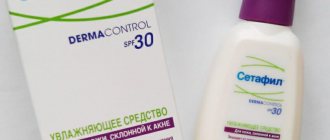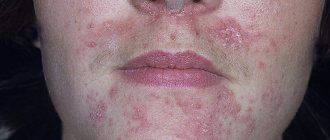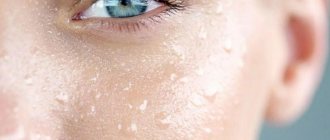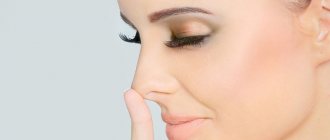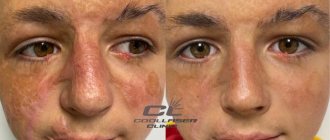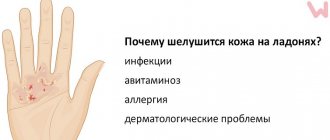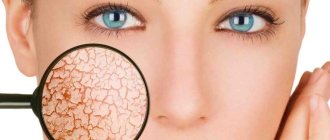- Xerosis, or dry skin. The tendency to it is inherited or occurs as a result of improper care, lack of water in the diet and, for example, when the protective skin barrier is damaged, which leads to increased transepidermal loss of moisture.
- Dermatoses. There is a whole group of diseases that provoke peeling: eczema, atopic dermatitis, allergic dermatitis, hyperkeratosis, etc. It is dangerous to fight them without medical supervision.
- Impact of adverse environmental factors. Dryness after a long walk in the cold or under the scorching sun, as well as after professional chemical peeling or dermabrasion, is inevitable if you do not use protective and restorative cosmetics.
- Some diseases of a non-dermatological nature. The skin on the face may become dry and flaky, particularly in a person with an autoimmune disease or hypovitaminosis. Consult your doctor to rule out internal causes of desquamation.
- Taking a number of medications. Peeling is caused, for example, by diuretics, as well as external agents, creams with high, therapeutic concentrations of acids or vitamin A derivatives.
- Age. Peeling of the facial skin and redness of the skin is observed in older people as a result of a decrease in the natural level of moisture in the dermis and epidermis, and a weakening of the skin’s protective mechanisms. This also happens in early childhood, since the epidermis is just learning to renew itself.
Why do women's faces peel?
In addition to the reasons already indicated, dermatologists associate peeling of the skin on a woman’s face with the onset of menopause or aggressive beauty practices. Thus, excessive use of peelings leads to a thinning of the hydrolipid barrier on the surface of the epidermis. And drying care dehydrates the skin, disrupting the normal mode of exfoliation of “dead” cells.
The habit of constantly following strict diets can also affect the condition of the skin.
Causes of peeling in men
It is believed that since an adult man’s sebaceous glands secrete more sebum than a woman’s, he should not have skin problems. However, regular shaving negates all the advantages: the blade leaves microdamages on the epidermis, and as a result, the integrity of the moisture-retaining hydrolipid layer is disrupted. Not shaving at all is also not an option, because the hairs themselves can cause irritation.
Peeling of the skin on the face in men often manifests itself for a more banal reason - perhaps the only aftershave balm for deep hydration is not enough in your case.
Let's summarize: even knowing why the skin on your face dries and peels, sometimes you cannot do without an experienced dermatologist. But there are some effective measures you can take on your own.
Structure of facial skin
It consists of three layers.
The uppermost layer is the epidermis, which is what our daily care mainly concerns. It bears the greatest load, as it is the first line of defense against negative environmental factors. The dermis goes deeper. It is in it that fibroblasts are located, the most important cells that synthesize collagen and elastin, structural proteins that maintain elasticity and prevent the formation of wrinkles. The care products we use do not penetrate this layer; it is affected by injection techniques. Next comes the subcutaneous fatty tissue, as well as connective tissue, which contains blood vessels and nerves.
If such a problem arises, then the first thing that needs to be established is how serious it is, and to what layer the changes have reached. If it concerns only the epidermis, then you need to select the appropriate care that matches the type of skin, the season and does not cause allergies. In some cases, a complex effect may be needed that will reach the dermis. A separate conversation about genetic or acquired diseases, which can be dealt with by taking special medications and using external agents.
Symptoms
Most often, dry skin is a temporary problem that only bothers you during a certain season, but it can last a lifetime. Symptoms of xerosis depend on your general health, age, where you live, and how much time you spend outdoors. Possible symptoms include:
- Feeling of tightness of the skin, especially after a bath.
- The skin is wrinkled and dehydrated.
- The skin looks rough instead of smooth.
- The itching is disturbing, sometimes very intense.
- Peeling of the skin - from slight to severe.
- Cracks in the skin, sometimes bleeding and painful.
- Redness of the skin, usually in limited areas.
Main causes of dryness
The main one is the lack of moisture in the stratum corneum. It is a consequence of a decrease in barrier function due to disruption of the lipid structure. Gaps appear in the protective layers between the cells, so water is not retained.
This process may be accompanied by disturbances in sebaceous and sweating, and a deficiency of amino acids in epithelial cells, which ultimately leads to dehydration. To find out deeper and individual reasons, tests and necessary examinations are done.
Dehydration
A decrease in water content below the physiological norm causes various changes in metabolism. They can take on a different character, be of high or low severity, and this situation cannot be ignored. A change in the state of the epidermis is a clear manifestation of dehydration, but other disorders may also occur. But first of all, we pay attention to changes in appearance visible to the eye.
Peeling of facial skin, its causes and treatment is a long process, although sometimes the starting point of the disease may be the simplest. For example, the general loss of moisture in the body, which leads to a change in the water balance of all tissues. This condition has its own characteristics:
- A person feels not just dryness, but tightness.
- With dehydration, a violation of the structure of the epidermis can be expressed implicitly, however, the irregularities are clearly visible when decorative cosmetics are applied.
- Expression wrinkles on a dehydrated surface are easily smoothed out after applying a moisturizer.
Improper care for combination and oily skin
Owners of this type, in search of optimal products, choose those that contain alcohol or drying components. This leads to a hydro-lipid imbalance, and therefore causes a deterioration in the condition of the outer integument. When abrasive peelings are used in combination with such compositions, the epidermis can be injured, and then you will have to look for the answer to another question: what to do if your facial skin is peeling.
Achieving a reduction in sebum production does not mean solving the problem. It is important that there is balance and harmony in the work of the glands. After all, without lipids it is impossible to maintain hydration, especially since a dry surface is more easily injured.
Sensitive, thin skin
This epidermis is otherwise called reactive or overreactive. From the name it is clear that it responds to all existing irritants more clearly, which means that the consequences of the negative effects of the environment or allergens have to be dealt with longer and the use of individually selected means.
Congenital characteristics and natural location may be the main reason why the skin on the face peels.
Reactive epidermis is divided into groups:
- with a low barrier function, easily losing moisture;
- inflammatory type;
- neurosensitive.
It is important to remember that this feature can be the result of aggressive effects, such as sunburn. That is why protective recommendations cannot be neglected.
Freezing
Skin peeling at low temperatures is also called “cold allergy.” However, in the vast majority of cases this is hardly correct. We often notice changes due to the fact that before going outside we use moisturizing cosmetics or decorative products containing water. Moisture particles at low temperatures turn into ice crystals and injure the epidermis.
"Repurification"
Why does the skin on the face of women, men, and children peel off after washing, and how to treat it in this case? After all, it would seem that such procedures should saturate it with moisture, but the effect is often the opposite. It's all about excess cleansing:
- If you use alcohol-containing products before washing, they can dry out the epidermis, and simply washing will not be enough to restore the balance.
- Aggressive soap with an incorrectly selected pH violates the integrity of the lipid barrier.
- Trauma from scrubs and exfoliants used for home cleansing ultimately causes discomfort and tightness.
Excessive peeling
Incorrectly selected, overly active abrasive compounds can cause peeling. A slight deterioration in condition after exfoliation is within normal limits. However, severe and persistent dryness is a sign that they are being done incorrectly. After manipulation, it is recommended to apply to the face:
- fat cream;
- Panthenol;
- thermal water.
Adverse external factors
If your facial skin is very flaky, the reason may be:
- using incorrectly selected rough cleansers;
- UV rays: solar radiation penetrates to the deep layers of the dermis, including destroying collagen and elastin fibers;
- overdried, overheated indoor air, which causes dehydration of both the outer skin and mucous membranes.
Decorative cosmetics with dry texture
Mistakes when choosing make-up, as well as creams, serums and lotions, are becoming a common cause of dryness. In particular, we must remember that the abuse of products containing mineral particles, including powder, blush and shadows, can negatively affect the relief. This kind of makeup has the property of absorbing moisture and ultimately leading to dehydration, not from the inside, as in most cases, but from the outside.
Using facial products around the eyes
This delicate area is highly sensitive. It needs the closest care because it is very thin and there is no fatty tissue underneath. That is why, to avoid peeling, you need to use products designed to care for this specific area. They contain active components in high concentration.
Allergies and other diseases
If questions arise about how to remove peeling skin on the face and how to treat it, then the doctor will definitely find out if you have any allergic reactions. It is possible that the change in condition is associated with an allergy to foods, pollen, dust, or the composition of caring cosmetics. It is believed that contact dermatitis is one of the main reasons for the deterioration of the condition. We must remember that the body’s response may be slow, but it is not always possible to directly associate the manifestation of a problem with contact with a certain substance.
During the examination, the dermatologist must say exactly what kind of disease the patient has, because it can be simple contact, seborrheic or atopic dermatitis.
What if you don't take care of your skin?
During the day, we expose our skin to temperature changes many times. There is an icy wind with snow outside, and warm air dried by radiators indoors. The contrast can be more than 20 degrees. The consequences of such differences are:
- dryness and feeling of tightness of the skin
- rosacea – enlargement of small vessels on the face
- cold allergy – when low temperatures become an allergen, causing swelling, irritation, blisters on the skin
- exacerbation of atopic dermatitis, psoriasis, herpes
- if the frost is severe, frostbite may occur
Lack of proper care leads to loss of skin elasticity, premature aging, and the appearance of age spots. Once acquired, rosacea will forever remain a cosmetic defect, which is quite difficult to combat.
Diagnosis of the causes of peeling skin on the face
You need to do some research first:
- collecting anamnesis to identify hereditary factors (many problems have a genetic basis) and characteristics of ongoing care;
- visual inspection;
- differential diagnosis to exclude diseases of internal organs and systems that lead to changes in the epidermis;
- skin allergy tests to determine the presence of specific reactions;
- bacterial sowing;
- scrapings and so on.
Based on the results, a clinical picture is obtained that the doctor uses.
Diathesis
Redness and dryness in a child are most often referred to by this term. As a rule, this is a general designation of the baby’s tendency to illness or severe reactions to products or care products.
In most cases, this is an analogue of allergic atopic dermatitis in an adult. Initially, it occurs due to errors in the mother’s diet, which affect the composition of breast milk.
When parents ask why the skin on the face peels, how to treat it and how to get rid of dryness on the body, the pediatrician prescribes treatment, and after an examination he will reveal the cause of the peeling. Recommendations will concern not only special cosmetics, but also the behavior and nutrition of the mother. In particular, you will have to exclude those dishes that cause a reaction in adults; bathing products without dyes, preservatives and fragrances are prescribed. The baby may be recommended to take the sorbent in a form that can be given to infants. It quickly removes allergens from the body and allows you to analyze which product the baby developed redness after eating.
Psoriasis
This is a chronic disease that causes patients great discomfort during exacerbations. As a rule, it manifests itself in people with a family history, but following a number of rules allows you to avoid its obvious manifestations.
Factors that provoke pathology include:
- Long-term negative impact of the environment, including sun, frost, and so on.
- The use of rough scrubs and traumatic cosmetics.
- Washing with regular soap.
- Using hair dyes that cause irritation on the scalp.
- Allergic reactions.
- Eating spicy, salty, fatty foods, as well as alcohol.
What to do to prevent the skin from peeling with psoriasis, the doctor recommends. The treatment program includes the use of hormonal drugs that cannot be purchased independently. Therapy should also include keratolytics and emollients, anti-inflammatory drugs.
Avitaminosis
The most important vitamins for the skin include:
- B1 – relieves itching and participates in the metabolism of proteins, lipids, and is responsible for the synthesis of connective tissue elements.
- B2 – improves nutrition, is part of respiratory enzymes, stimulates regeneration.
- B5 is a component of redox processes.
- Pantothenic acid – has a protective effect, relieves inflammation.
- B6 – its deficiency can be one of the main causes of flaking of the skin on the face; it is prescribed for various dermatoses.
- Folic acid - indicated for hyperkeratosis, patients with psoriasis, relieves itching.
- Nicotinic – needed in reparation processes (not prescribed during periods of sharp exacerbation of allergic reactions).
- B12 is a remedy for photodermatoses, neurodermatitis, and so on.
- H (biotin) – its deficiency is accompanied by dry skin and the appearance of scales.
Mycosis
Fungal infections occur quite regularly today, including due to weakening compliance with sanitary and hygienic standards. With these diseases, “flakes” look like small lesions, and scales also appear in the hair. The spots can be pink or red, in their center the epidermis dries out. Small areas of the lesion merge as they progress, causing serious discomfort. Sometimes hair is affected and becomes thin and brittle. Most often, infection occurs from animals.
Seborrheic dermatitis
This disease is also called eczema and is a common cause of irritation on the face. The chronic disease is characterized by inflammation, slight itching, and the skin on the cheeks begins to peel off. It is common among both adults and children, including sometimes affecting newborns.
The causes of the disease include:
- decreased immunity;
- heredity;
- changes in hormonal levels;
- stress.
As a rule, the areas of greatest damage are in the eyebrows, on the bridge of the nose and in the nasolabial folds. A doctor should determine what will help with peeling skin on the face.
Ichthyosis
With this diagnosis, the process of keratinization is disrupted. The disease is hereditary in nature, and scales appear on the surface (hence the name). Some areas thicken, while in others, on the contrary, the epidermis becomes very thin. And improper absorption of vitamin A causes keratin accumulation and hardening. In severe cases, areas of inflammation and blisters appear, and a violation of the protective barrier makes the outer skin very vulnerable to infections.
Patients with scaly dermis may also have other problems. Perhaps their thermoregulation is impaired, their metabolism is slowed down, and the activity of enzymes involved in oxidative reactions is increased. This leads to disruptions in the functioning of the endocrine system.
There is currently no treatment, since the source is genetic mutations. However, care rules must be followed: constant moisturizing of the epidermis, keratolytic therapy, and dosed ultraviolet irradiation are necessary.
Treatment
It is not recommended to use drugs other than antihistamines on your own. In most cases, they are enough to eliminate the main symptoms and relieve swelling. It is necessary to take into account that the action must be comprehensive and must include creams, ointments and gels to relieve external signs of the disease.
Preparations for internal use
Medicines prescribed by a doctor are divided into corticosteroid and non-hormonal. The first are produced on a hormonal basis, have a powerful effect, but have a number of serious contraindications for long-term use. The second, milder ones, are prescribed to relieve mild forms of irritation. Several generations of antihistamines are available in pharmacies. If the former, such as Suprastin, influenced the level of attention, causing drowsiness and inhibition of reactions, then Cetrin, Telfast, Claritin, with high efficiency, do not give side effects that could become a limitation for work in areas where concentration is required.
Cosmeceuticals and their help in the fight against allergies
When the body reacts violently to a stimulus, skin lesions are sure to appear, and sometimes quite unpleasant ones. These are not only rashes and pimples, but also increased dryness and microcracks. Their danger lies in the possible entry of bacteria and the development of local inflammation. The main task, along with eliminating illness, is strengthening the immune system. Cosmetic products from the medical corporation "RHANA" are used in professional problem solving, provide a quick and lasting positive effect, allowing you to maintain beauty, health and prevent premature aging. And the skin is susceptible to it if an allergic reaction often appears on the face, a photo of which clearly demonstrates the degree of damage to the integument.
In order to give a fresh look and ensure cellular renewal, it is recommended to use placental preparations:
- Modeling mask with placenta hydrolyzate GHC Placental 3D Mask withQ10. It will prevent the risk of developing inflammation and give a healthy tone.
- Concentrate serum for intensive revitalization GHC Essence will instantly restore inner radiance, and also improve microcirculation and cell nutrition.
- LNC Repairing Cream with a moisturizing effect will preserve the beauty and freshness of the skin, and also protect it from moisture loss and eliminate the regeneration of ceramides (epidermal cells).
- Placental antioxidant lotion concentrate LNC Toning Lotion will protect cells, normalize melanin production and provide optimal hydration.
The dangers of self-medication
According to preliminary forecasts, the number of people reacting to certain stimuli will reach almost 90% by the end of the century. Allergists-immunologists mention the fault of allergy sufferers themselves, who, by self-medicating, expand the range of allergens and provoke the development of other diseases. In this case, the part is fixed and passed on by inheritance. By identifying the cause and drawing up an optimal treatment regimen, you can almost completely eliminate the likelihood of regular exacerbation of allergies.
How to get rid of dry skin on the face and remove imperfections: how to treat peeling
Many people try to solve the problem with home remedies, recipes, or use creams that they buy in a regular store. However, descriptions and recommendations on the label are often not enough - depending on the underlying processes in the body, qualified assistance from a dermatologist, allergist or cosmetologist may be required.
As practice shows, approximately 85% of patients ask this question. To effectively cope with discomfort, a combination of anti-inflammatory and exfoliating agents is optimal. Also recently, the role of steroids in therapy has been growing. And in the presence of concomitant diseases that affect the condition of the epidermis, doctors of several specialties must work in close collaboration.
Winter care mistakes and how to avoid them
In winter, the skin requires special attention and delicate treatment. The most common care mistakes involve using harsh products or cleansing methods. The following are contraindicated for skin in winter:
- scrubs with abrasive particles
- hot water
- "summer" cosmetics
- no UV protection
- rubbing with a towel “to warm up”
- dry makeup
In winter, you should follow a simple skin care rule: all cleansing, exfoliating procedures, as well as moisturizing, are best done in the evening, shortly before bed. Protective cream should be applied to exposed areas shortly (half an hour) before going outside.
Tools Overview
It is known that health and beauty are guaranteed by competent three-step care, which includes:
- cleansing;
- toning;
- hydration.
At each stage you need to use appropriate cosmetics; this is the best combination that answers the question of what to do if the skin on your face is constantly peeling.
In therapy today, products made on the basis of placenta extract are increasingly used. One of them is the Japanese placental drug Laennec. Being a hepatoprotector and immunomodulator, it affects the state of the body's defense mechanisms, and therefore reduces the severity of allergies. It includes:
- Cytokines and peptides that provoke an immunological reaction.
- More than 36 cell growth factors.
- 18 amino acids, including essential ones, to prevent unwanted cellular oxidation and prevent the action of free radicals.
- About 100 protective enzymes and 40 vital minerals.
- Vitamins B1, B2, B6, B12, C, D, E.
- Hyaluronic acid to optimize water balance and moisture retention.
Experience has already been accumulated in the successful use of the drug in the treatment of atopic dermatitis. Cytokines included in Laennec activate cell metabolism and prevent the development of fibrosis.
Cleansing
An important stage, without which maintaining health is impossible. Timely removal of dead cells, excess sebum, cosmetics, dirt particles, and opening of pores normalize breathing and renewal of the epidermis. Let's list the main steps on what to do when the skin on your face is peeling:
- Wash your face with warm water.
- Use gentle products selected according to your skin type.
- Remove eye makeup with a special milk designed to care for delicate and sensitive areas.
- Blot rather than wipe your face.
- Use lipid-restoring drugs and formulations with hyaluronic acid.
Peeling should only be done by a cosmetologist, who will select the components specifically for individual sensitivity. Independent use of acids can become a trigger for the appearance of new “peels”.
Serums
This is one of the essential treatments for flaky skin. They contain active substances in high concentrations, and when applied to a well-cleaned surface, they work especially effectively. To moisturize, use cosmetics containing hyaluronic acid, pay attention to its shape. It is believed that from the outside it does not penetrate the epidermal barrier, but low molecular weight is most likely able to overcome it.
Creams/emulsions/balms
What to do if the skin on your face is peeling - the reasons that the doctor will find out will suggest the direction of possible therapy. And at home, you can use compounds that increase barrier properties and prevent moisture loss. Typically they contain:
- substances that form a protective film;
- probiotics;
- vitamins;
- oils
Features of care in winter
During the cold season, it is not only the skin of the face that needs care: no less attention should be paid to the body, hands, lips, and feet.
Body
Body care in winter consists of regular hygiene procedures using mild detergents containing glycerin and vegetable oils. The water should not be very hot. After bathing or a refreshing shower, it is useful to apply moisturizer to the skin of the body.
Hands
The skin of the hands has weaker natural protection than the face or body, and is significantly exposed to external factors. Hand skin care in winter consists, first of all, of its mechanical protection from the cold. Wearing mittens and gloves not only helps keep you warm, but also protects your skin from hypothermia and frostbite. The skin of your hands also needs to be moisturized and protected by selecting appropriate creams for this.
Lips
The skin of the lips is very vulnerable to exposure to low temperatures. In the cold, lips quickly dry out and crack. Taking care of your lips in winter involves constantly moisturizing them. Hygienic lipstick or balm is suitable for this purpose. These products should be applied not only before going outside, but also indoors.
Face
Facial skin is defenseless in winter without special care. It cannot be completely protected from frost and wind, and damage caused by exposure to cold air is very difficult to disguise. Facial skin care in winter should be especially thorough, competent, consistent and regular. All skin care products must be selected taking into account the needs of this skin type and the individual characteristics of the body.
What folk remedies can be used
At home, the main principle is to do no harm, choose the softest and most gentle compositions.
For example, at home you should not use abrasive peels, but rolls that do not injure you in any way. They collect dead epidermal cells due to the content of cellulose and starch, which do not scratch or leave microcracks.
When it comes to creams, it is better to take those intended for home care. When going outside, be sure to apply sunscreen.
If we talk about masks based on fermented milk products or oils, cosmetologists recommend trying them first on the skin of your hands. All homemade cosmetics can cause an allergic reaction, which will only worsen the consequences.
Dry patches with scales
Pink, raised, dry patches on the body and head may indicate psoriasis. With this dermatological pathology, raised plaques appear on the skin of a person - psoriatic papules. They protrude above the surface of the skin, cause intense itching and flake, and tend to spread and coalesce.
Psoriasis is a chronic autoimmune disease in which rashes are most often localized on the elbows, head, knees and groin. Dry pink spots covered with white scales are foci of chronic inflammation. Under the influence of internal autoimmune processes, epidermal cells divide several times faster than necessary. As a result, small flakes of dying skin cells are constantly separated.
How to get rid of a problem from a cosmetologist
Before you go to a specialist, we recommend that you find out whether he has a license and the appropriate qualifications. Unfortunately, recently offices have often opened in which the situation can worsen: cosmetology is a branch of medicine, and conventional courses for correct diagnosis and choice of treatment are not enough.
At your appointment, a certified professional cosmetologist will recommend how to get rid of peeling skin and what procedures can be carried out for this. Among them:
- Special corrective care with cosmetics that penetrate the epidermal barrier.
- Paraffin therapy – liquid warm paraffin creates a greenhouse effect that helps moisturize the skin.
- Biorevitalization is an injection technique for introducing preparations based on hyaluronic acid into the upper layers.
- Gentle acid peeling, which is indicated when the cause of dryness is not a serious systemic disease.
How to diagnose allergies
The main difficulty is to distinguish it from a skin disease. Rashes should not be a reason for panic, but a prerequisite for examination. To prevent exacerbation and speed up the process of identifying causes, it is necessary:
- try to independently identify the allergen by eliminating cosmetics or products from everyday use, doing this gradually in order to replace the changes in time;
- take an antihistamine that has already been used as prescribed by a doctor;
- Remove all alcohol-based external care products from use.
After such measures, it will be much easier to determine how to relieve an allergic reaction on the face and alleviate the general condition.
We recommend
GHC Placental 3D Mask withQ10
Serum concentrate
Repairing cream with a moisturizing effect
Placental antioxidant lotion concentrate
Balanced nutrition as a means of combating
A calculated diet is one of the important conditions for maintaining beautiful and healthy skin. It should be enriched with fish dishes that contain omega-3 fatty acids, as well as vegetable oils.
Avocado contains beneficial components; it helps retain moisture in the epidermis. The condition is improved by substances found in greens and green vegetables. The nutritional components contained in eggs have a beneficial effect: amino acids, vitamins, folic acid.
Laennec drug and super-thin injection needles Nanoneedle
Laennec - injection solution No. 10
Curacen / Curacen
Nanoneedles with ultra-thin walls 30G
Nanoneedles with ultra-thin walls 33G
Let's sum it up
If you experience symptoms of deterioration in the condition of the outer skin, including redness and itching, we recommend that you consult a doctor without delaying. Make an appointment with a dermatologist, dermatovenerologist, cosmetologist (beauty salon specialists do not always have higher education, so we advise you to make an appointment at the clinic). The sooner a specialist determines the reasons for the change, the faster adequate treatment will be selected, relapse prevention will be provided, and the question of how to get rid of peeling on the skin will be answered.
Forms and complications of seborrheic dermatitis
There are pediatric and adult forms of seborrheic dermatitis.
Sometimes the disease is associated with psoriasis (seborrheic psoriasis).
The severity of the disease varies from mild dandruff to severe erythroderma. Dandruff affects the scalp in the hair growth area. In 70% of children, seborrheic dermatitis usually appears by 3 months of age and resolves spontaneously by 6-12 months.
In adults, seborrheic dermatitis begins in adolescence. Predominant in young and elderly people. More often affects men.

